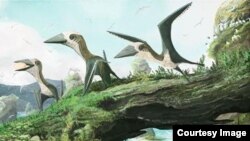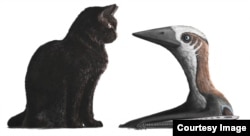Researchers are describing what could be a new species of flying dinosaur that was about the size of a cat.
The partial remains of the diminutive pterosaur that lived about 77 million years ago, were discovered in 2009 in British Columbia. Pterosaurs were the first vertebrates that could fly.
“This new pterosaur is exciting because it suggests that small pterosaurs were present all the way until the end of the Cretaceous, and weren’t out competed by birds,” said lead author of the study Elizabeth Martin-Silverstone, a palaeobiology PhD Student at the University of Southampton in Britain.
“The hollow bones of pterosaurs are notoriously poorly preserved, and larger animals seem to be preferentially preserved in similarly aged Late Cretaceous ecosystems of North America. This suggests that a small pterosaur would very rarely be preserved, but not necessarily that they didn’t exist.”
The specimen described in the paper had a wingspan of a mere 1.5 meters. Pterosaurs of that era were generally much larger with wingspans from four to 11 meters, researchers say. The largest known was as big as a giraffe with a wingspan of a small aeroplane.
Despite the fragmentary nature of the remains, researchers are not yet able to determine if they represent a previously unknown species, but they were able to determine the small pterosaur belonged to a kind of short-winged, toothless pterosaurs called azhdarchoids.
“The specimen is far from the prettiest or most complete pterosaur fossil you’ll ever see, but it’s still an exciting and significant find,” said Mark Witton, a pterosaur expert at the University of Portsmouth. “It’s rare to find pterosaur fossils at all because their skeletons were lightweight and easily damaged once they died, and the small ones are the rarest of all. But luck was on our side and several bones of this animal survived the preservation process.”
He added that despite the small size of the creature, it was full grown, not a juvenile.
Furthermore, researchers say the discovery adds to a “growing set of evidence” that the Late Cretaceous period was more diverse, with both large and small species of pterosaurs.
The paper was published in the Royal Society journal Open Science.










